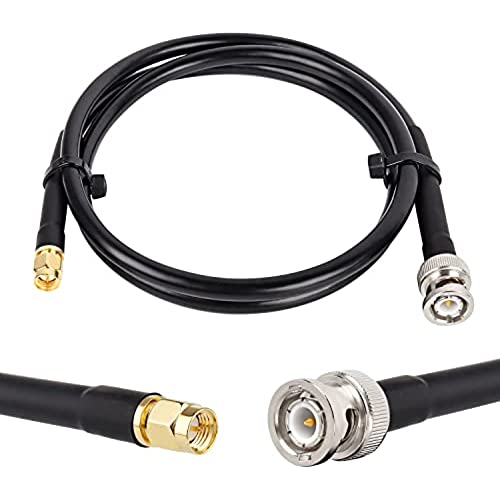
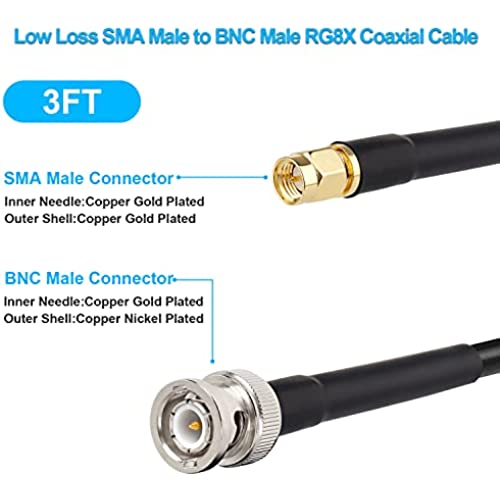

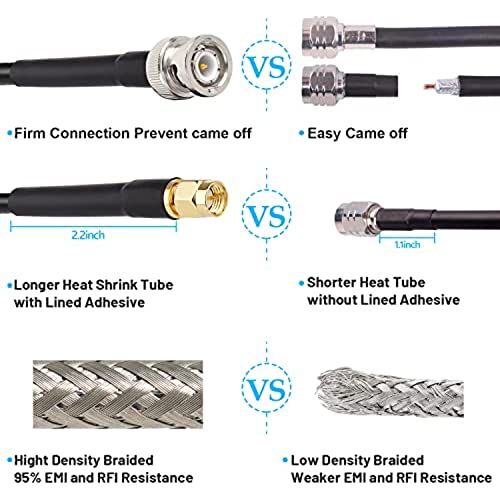
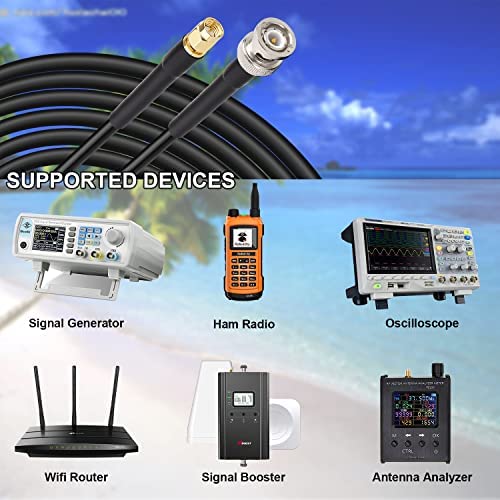
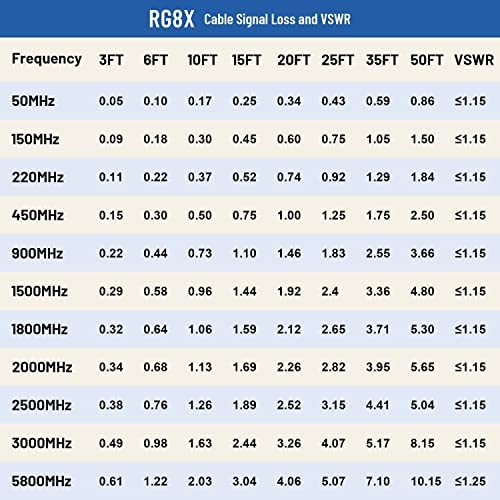










MOOKEERF SMA to BNC Cable 3ft SMA Male to BNC Male Cable SMA BNC Adapter Cable RG8X Jumper Cable for RF Applications/Antennas/Wireless LAN Devices/Wi-Fi Radios External Antenna
-

MinnesotaDrew
Greater than one weekThis cable seems to be well made. It is a little stuff as a result of having the solid core inner wire, but in my application it wont be moving much once its installed in the car. I wanted to have a short cable to a small antenna for scanning on the side with my handheld, which has a BNC end that matches this cable. The connectors look like they are nice parts and the heat shrink is well done. I dont have any meters or equipment sensitive enough to measure any power loss on a piece of coax this short, safe to assume it is indeed very low loss at the 6 foot length. I am very happy to not be needing to use adapters for my use case.
-

MrTechieMan
> 3 dayI have several HAM radios that all have SMA Female sockets on them for antenna connections. I prefer BNC and have started to make them standard on all my antennas. For remote deployment of an antenna with a BNC connector into an HT type transceiver without a BNC adapter, this is perfect.
-

Douglas W.
> 3 dayI like everything about these cables but that they are a bit stiff (to be expected with RG8X...) and that they are not made in America. While this cable is substantially long at 15 feet it means I can transmit to my dummy load while it is in a safe place in the garage. The dummy load weeps some oil out of it as it is a 1 gallon can filled with resistors and oil. The cable works well for sending low power RF signals to a spectrum analyzer for study or troubleshooting. MOOKEERF makes nice prefab cables and this one is no exception.
-

Steve
> 3 dayI have quite a few Moonkeerf cables now and have impressed with the quality. This RG8x cable is no exception. It has very low loss. I have ran this from one of my hf radios to a dipole outside. I did add an SMA to UHF adapter to connect it to the tuner. Getting great readings on the nanovna. Moonkeerf does a great job on the connections and heatshrink on the ends.
-

Ben K.
> 3 dayI needed this cable configuration to adapt an outdoor antenna to a stationary ham. The cable was long enough to pass through the wall, and route it up to the roof where the antenna is mounted. The signal doesnt seem to be impeded and there was no noticeable static after the addition of this cable. The heat shrink on the connections is usable, but I further weatherproofd them.
-

Heather N.
> 3 daySo for what this is advertised as, its fine. It is a Coax cable with the connectors as listed. However, I ordered this to modify it to be part of a HAM radio setup, and found that this is the first Coaxial cable I have ever encountered that I could not solder to it. I have never encountered that, so I am unsure what kind of metal this is. If you need a coax cable just as this one is configured, then it will be fine, pretty well made. However, dont order if you intend to modify it for any purpose and need to solder it.
-

Tech Bear
> 3 dayThis is on me. I quit reading when I saw RG8x and ordered it. I should have looked at the specs better. The first indicator for me that it was different than what I was used to was how stiff the coax is. Thats because it has a solid core. This is fine if you will be using it in a fixed location. I was expecting the typical stranded center conductor which is a much more flexible and reliable coax for field use. After going back and reviewing the listing, this coax looked more like RG9 or RG6 Dual Shield coax (which is a 75Ohm cable). So, I checked it out with a vector network analyzer and compared it against some known RG8x cable. When checked for loss it was the same spec. When checked for impedence, it showed 50Ohms as expected. Next I cut it open to check how good a coverage the braid and shield were providing. Looked good. I wish this coax had a stranded core. Other than that, seems to be a nice cable that meets specs.
-

BobK
> 3 dayI got this to connect my nanoVNA to various devices around the shack such as antenna tuners and baluns and such. What I like: High quality connectors and cable. Strong strain relief at each connector makes it unlikely to fail at the joint. Their claimed cable loss is exceptionally low. I didnt measure the loss, but it certainly feels low-loss based on quality of the connectors and stiffness of the cable. What I dont like: the cable is very stiff. In fact, I decided not to use it with my nanoVNA whose SMA connector is not very robust and im afraid it would eventually be damaged by using such stiff cable. Instead, Im using a short length of RG174, which is flexible enough to take the strain off the nanoVNA. Although RG174 is lossy, a 3 ft long cable should have negligible loss for my applications. Note that Im only interested in frequencies below 30 MHz. For VHF and UHF applications, low loss cable like this would be much more important.
-

Joshua Senecal
Greater than one weekThis is by all indications a well-made jumper, exactly as advertised. I took mine apart to get a better idea of the quality, and heres what I found. First, it arrived coiled up as in the attached photo. I dont care for the tight bend in the cable on the end with the SMA connector. They didnt do that to the end with the BNC connector, so there wasnt a need to do that to the other end. The connectors at each end are crimped on and each end is protected with a significant length of heat-shrink. It is thick and very tough, providing some additional strain relief on the crimp connection as well as protection. Underneath the heat shrink was the crimp connection. On inspection I would describe the quality of the crimp as between good to very good. Its not as good as the crimps on some high-quality jumpers I have, but its more than suitable for the intended purpose. I stripped off some of the PVC jacket (very thick and tough) and found a very good tinned braid underneath. Under the braid the dielectric was coated with an adhesive foil, just as advertised. The center conductor is solid copper. Overall it appears to be a very good jumper for the price. I cant comment on how long the cable will last (coax does wear out), but it seems to be well made with good coax and connectors. The jumper is not advertised as being suitable for outdoor use; I would say this is good for indoor use and temporary outdoor use as long as its not subjected to rain or similar. I will certainly be able to get some use from this around my Amateur Radio station. My only major concern with this jumper is the lack of labeling on the coax itself. The only thing the coax has on it is its type (RG8X) and the fact that its low-loss (see picture). And a number. All good jumpers are made with coax that has a lot of information printed on it, including things like the manufacturer, information about the jacket, and possibly thermal and electrical properties of the cable. This coax is probably just fine, but if the company wants to really win the respect of the techie types, the coax should provide more information on it.






